At completexbox we are very much community driven, and welcome guest articles, opinion pieces and reviews. This review of Dorfromantik is written by Cerysnetics from the completexbox discord / community, and what a fantastic review it is, enjoy!
Dorfromantik is an extremely relaxing and comforting game, and at a time where I’ve had unplanned hospital visits, getting kids ready to return to school, 30+ degree temperatures and then boiler issues (not a euphemism) I have longed for a little of both.
Introduction
First released on windows back in 2022 and the work of four Swiss and German university students, the name literally translates to “Village romanticisation”, a nostalgic feeling for being lost, one with the countryside.
It spawned a physical boardgame in 2023, with a 2 player competitive variant the following year, and more recently a “Sakura” alternative of the original game, with a Cherry Blossom mechanic and Japanese landscape theme.
A strategy puzzle game, Dorfromantik has a gently charming, simple artstyle which compliments the “romanticisation” of the name, small touches of animation here and there bring the landscapes to life, creaking windmills spinning, a flock of birds flying overhead, and trains & boats populating tracks and rivers as you expand your landscape. A light touch with sound effects as you pan your world adds to the meditative feel too, as does the simple yet relaxing music.
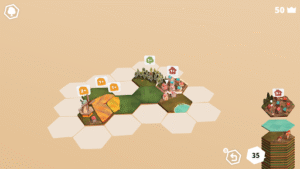
An early start. On the left 2 fields require at least one, and the windmill two more matching tiles to complete the mission.
The forest and village need one more tree, and one more house respectively.
Gameplay
The player, starting from a single blank hexagonal tile, grows a landscape from a pile of tiles generated at random with only the current and next two tiles being visible. There are 6 variants of these tiles, Grass, Trees, Village, Field, River and Track. Simply put, if two sides match when connecting tiles then the player will get points. Tiles can be rotated and must stick to an existing tile though you do not need to match tiles perfectly, a forest on one edge can butt up against a house or field, (there are more restrictions with water and track tiles where they cannot end in an abrupt fashion).
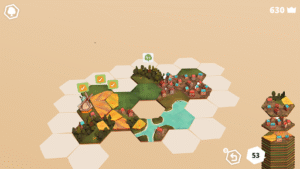
Those water tiles were perhaps hastily placed, the centre tile is now dependent on a specific water tile to close. Eagle eyes may notice that the three field missions (and one village mission) completed each granting a further 5 tiles to our pot.
From there you could simply go about building your lovely little impressionist world, indeed the game comes with a creative mode which does allow you to construct to your hearts content, no limits on tiles, control over tile probabilities, which biomes you will see and the ability to discard those you don’t wish to use.
The main mode of the game however, starts you with 40 tiles in your pot, and charges you to simply create as much as you can before you run dry. Fortunately one can receive extra tiles from completing quests which pop up as you play, which nudge you into creating separate and pleasing regions of your world. Occasionally you’ll draw a card with Trees, Village, Field, River and track which has a number, your mission for this tile will be to place that tile in a matching group which reaches or exceeds that number. You could for example draw a card with trees on all six edges of the tile, which allows you to add further cards on every edge, with a number of 100+, you simply need to increase that group (or add to an existing group) until you reach 100 or more trees, where upon you complete the quest and receive more tiles. When you receive a tile with a small flag that indicates you must “close” those edges upon completion to win further points.
Which then leads to a satisfying loop where you both want to close an area if you have one of these flags, but if you can continue to add further tiles with missions attached to that group to make an even bigger forest quickly and then close multiple flags in one for a lovely little shame free dopamine rush without a loot box in sight. You end up considering “how long can I wait” and starting new forests on other sections of the map to help in the future. This is of course the same mechanic for villages, fields, rivers and tracks.
Other times you draw a tile which has a number but without a plus sign to indicate a hard limit of exactly that number. A village tile with 15 means you can only add it to, or add to it up to 15 other houses, this encourages you to build in other areas and not just sit on ever expanding areas. The strategy is, to think ahead as much as possible from your own experience with the types of tile to plan ahead. It is immensely satisfying to complete a mass batch of flags and quests from good planning and receiving a glut of extra tiles as reward. You can receive bonus points for “perfect” tile placement where every side of a tile matches its neighbours, you can end up in quite a meditative state when trying to complete as many perfect tiles as possible.
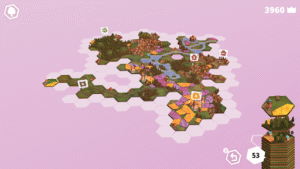
Multiple quests are in progress, (from the left clockwise) we need exactly 5 train tracks, at least 36 trees, with a flag from a prior mission, a small village needs only 3 more houses and will generate a flag, a larger village at least 45 houses and finally a field needs 8 further tiles and will also generate a flag.
That’s not to say the game forces you, after all its the soothing look back on a beautiful world with both a chaotic design and with your own will that can be the true “win” state here. Like a day after you’ve painted a room and just stood hand on hips to enjoy how pretty it is, or that day you reorganised your bookshelves and candles to get that just perfect feel as you sit down with a cuppa.
Sure a run where you end with a massive world and armfuls of points is a great thing to look back on, but those worlds which weren’t quite so immense are no less magnificent for their smaller size.
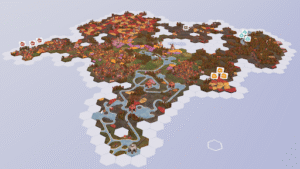
The end of a run, with some missions left incomplete, it’s still a wonderful record of the world you built and have one last “walk” around. You can see in the bottom right side of the void, a hidden challenge which was not unlocked this time. Time for another try!
The game also has hidden challenges, seen in the distance of the void, a small hollow hexagon. Reaching these and completing the quest there, will unlock a new tile and you will be able to review the “Rewards” section of the menu to see harder and harder versions of that challenge which will reward you with new cosmetic versions of the tiles you already have, some different fountains, a clock tower, or granary, also additions such as new animals to populate your rivers and lakes.
Indeed this could be, for some, a weak point as it could be seen as the sole “carrot” to keep you playing. The games simplicity could be seen as a weakness, for me, however the joy of simply creating for creations sake and receiving delightful additions to add the variety of your worlds is reward enough. It being a wonderfully comforting game to return to time and time again as one would a GaaS, is also an ample reward.
Outside normal and creative mode the game has a hard mode where tiles are fewer, and the type of tile less generous in flexibility with fewer quests. Also a “quick mode” where tiles are limited in that you have a hard limit on “tiles placed”.
Given you can spend at least 90 minutes on a world in normal mode this is a nice short option to enjoy over a break, personally I’ve enjoyed this mode greatly as I bimble about between chores and boiler repair when I get some time to enjoy a cup of tea and a biscuit. There is also a monthly “score challenge” where you complete a world with specific tiles with a theme and fixed biome, for example this month’s challenge is Big Lake!, where you can replay over and over to score yourself against the community.
Closing thoughts
In terms of options and accessibility the game is rather simple. No keybinding is a sadly missed feature for me as I would love to control what the triggers and bumper buttons do outside the default, it can become cumbersome for me as my world increases in size to move around it in a satisfying and comfortable way. Similarly there are no visual accessibility options such as a high contrast mode or an option to make the glowing edges to show “perfect” placement more apparent. The white Hexagonal outline is sometimes easily missed in the pale pastel void outside your tiles. Sadly missed from the PC version (at least for now) is the option to turn your finished run into a creative world where you can continue to build and lose yourself.
Nevertheless Dorfromantik remains a delightful and soothing game for me and my kids both. A game I’ve loved since its PC release, to the point of buying both cooperative/solo boardgame versions and have been eagerly awaiting a console release to jump in here too. If you have lost yourself to games such as Islanders, or Townscaper or even the kind of board game from which Dorfromantik is inspired by, you could do little better than considering diving into its soothing, welcoming arms.
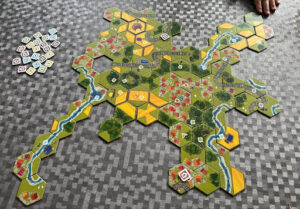
Boardgame Drofromantik is not only as calming and relaxing to play but also includes scoring, challenges and unlocks for getting better at the game.
Overall
-
CX Score - 90%90%
Summary
Pros
- Wonderful aesthetic
- Simple to pick up and understand
- A relaxing and chill “puzzle”
- Pick your own fun, for the joy of the creation or to chase a better score.
- Feels like a boardgame
Cons
- No real accessibility options
- Control scheme doesn’t allow me to lose myself into the game as much as I would like

